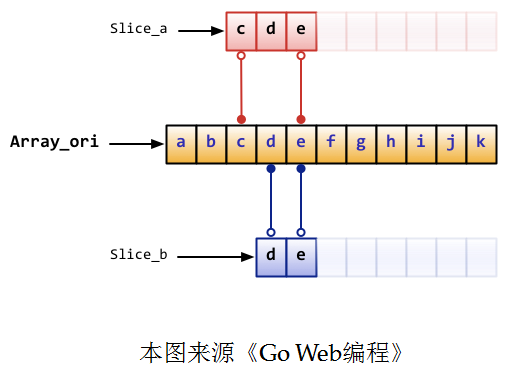定义
切片本身不是数组,它指向底层的数组或者数组的一部分。因此,可以使用Slice来处理变长数组的应用场景。 Silice 是一种引用类型。
1、定义一个空的Slice
package main import ( "fmt" ) func main() { var slice1 []int //定义一个Slice, []里面什么也没有!! fmt.Println(slice1) }
2、 从数组中干获取Slice
func main() { arr := [3]int32{1, 2, 3} // 定义一个数组 slice := arr[0:len(arr)] //从数组中取得Slice,从0开始,取到结束 fmt.Println(slice) } //output [1 2 3]
3、使用“make”关键字创建Slice
make([]T, len, cap)
[]T - 表示定义那种类型的Slice
len - 表示Slice的长度
cap - 表示Slice的容量;可以省略,即cap=len
s1 := make([]int, 3, 5) fmt.Println(s1) //output [0 0 0]
Slice与底层数组的关系图

通过关系图,我们可以得出: Slice_a 长度为3,容量为9, Slice_b 长度为2,容量为8
Reslice
有 Slice 再次生成的Slice。它的特点是:
1. 索引以Slice为准。
2. cap不能超过Slice
3. 索引越界不会从新分配内存,而是直接出错!!
a2 := [5]byte{'a', 'b', 'c', 'd', 'e'} s2 := a2[0:3] fmt.Println(len(s2), cap(s2)) // output 3, 5 s22 := s2[0:2] fmt.Println(len(s22), cap(s22)) // output 2, 5
Append 函数

a3 := make([]int32, 2, 4) fmt.Printf("%v, %p ", a3, a3) a3 = append(a3, 1, 2) fmt.Printf("%v, %p ", a3, a3) a3 = append(a3, 1, 2) fmt.Printf("%v, %p ", a3, a3) //output [0 0], 0x114821d0 [0 0 1 2], 0x114821d0 [0 0 1 2 1 2], 0x11489c60
copy 函数
copy(src, dst) - 将dest的切片 copy 到 src, 以两者之中最短的切片长度为准。
a1 := []int32{1, 2}
a2 := []int32{3, 4, 5}
fmt.Println(a1) // output [1 2]
copy(a1, a2)
fmt.Println(a1) // output [3 4]
copy(a1[0:2], a2[1:3]) // // output [4 5]
fmt.Println(a1)